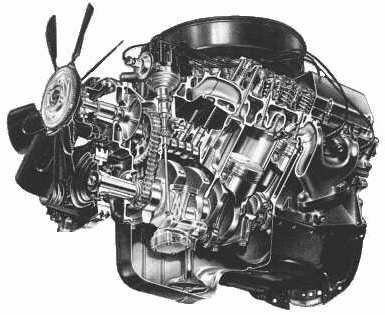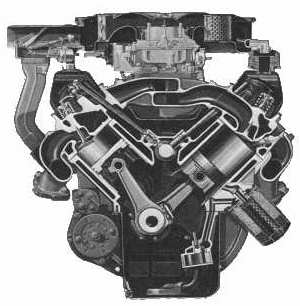
|
|
|||||||||||||||||||
|
The 429 "Thunder Jet" was introduced in 1968, installed in Thunderbirds.
The 429/460 engines are known as the "385" family. Its poly-angle canted valve quench chamber cylinder heads are often compared to the 351 Cleveland. The Boss 302 used this style cylinder head a year before the 351C, and the 429 a year before the Boss 302. (and Chevy had them years before that, which we'll quietly ignore) |

|
|
The 429/460 uses a cylinder block designed along the lines of an overgrown
Small Block (bore spacing 4.90" vs. 4.38").
It is a thin wall casting with a maximum
recommeded overbore of .030". The engines have a very oversquare bore/stroke
ratio and a very strong bottom end. Coupled with the free breathing canted valve
heads makes the 429 ideal for making serious horsepower.
In 1970/71 the Cobra Jet and Super Cobra Jet versions were offered. The 429 SCJ featured a block with 4-bolt mains at the first four positions, forged pistons, heads with larger valves and ports, spot faced rod bolt seats, solid lifters, screw-in rocker studs and pushrod guide plates. The 429 CJ is similar but with a hydraulic cam. 2-bolt mains were used in 1970, 4-bolt in 1971. Pre-1972 429s use the more Ford-traditional 18mm spark plugs, while the CJ and SCJ used 14mm plugs presumably to make more room for larger exhaust ports. In 1972 all went to the 14mm plugs. The intake ports on these engines are so large and extend so close to the valve cover, the bolt holes are drilled clear through the ports. This will cause a vacuum leak if you try running the engine with the covers removed. Early 429s used 1.75:1 cast iron rocker arms with guide lips like the 289 and 302, then later switched to 1.73:1 351C sled fulcrum stamped steel rockers. 429/460 rockers are interchangable with those from the 351C. Cheaper but interchangable are rockers from a big block Chevy. |
|